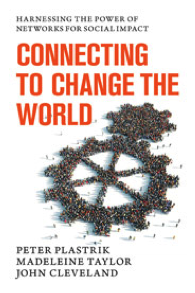I became aware of the power of networks in the 1990s while working in the field of community economic development (CED) overseas and in Canada. While the majority of the microenterprise programs were supporting individual entrepreneurs to establish their own businesses to generate additional income for their households, the pioneers at the Appalachia Center for Economic Networks were weaving together small and medium enterprises into mutually supporting economic networks. The difference in revenue, profits and economic activity was dramatic: networks really exemplified the old adage that the whole can be greater than the sum of its parts.

The popularity and practice of networks has since exploded. People are building networks for every possible reason: from developing personal connections to mobilizing diverse organizations to address complex environmental, social and economic challenges. Policy makers use network frameworks to understand the resiliency of terrorist groups and business analysts study networks to assess the buying habits of consumers. There are now a bewildering array of networking tools and techniques (e.g. network mapping software).
Despite the "mainstreaming" of network concepts and methods, there are few comprehensive resources to help practitioners attend to all the practical tasks of building and managing these productive webs. Until now. The book, Connecting to Change the World: Harnessing The Power of Networks for Social Impact by Peter Plastrik, Madeleine Taylor and John Cleveland, more than fills the gap. Drawing from diverse examples of urban sustainability, manufacturing, homelessness, and faithbased communitybuilding, the authors have put together what may well be the best guide for practitioners to date.
It is comprehensive. The first chapter discusses the different wants that networks can add that can make a difference to wouldbe changemakers. Chapter Two reviews the eight key characteristics of networks (e.g. purpose, governance, operating principles). Chapter Three explores the art of weaving a network's participants. Chapter Four lays out the phases of evolution of networks, while Chapter Five uncovers the key functions that network stewards need in order to manage the entire process. Chapter Six provides a clear framework for assessing frameworks and Chapters Seven and Eight offer a (brief) summary of key challenges and simple things to keep in mind when the going gets tough.
Beyond this comprehensive content, the book is also a gold mine of resources. The appendices include lists of relevant websites, books, case studies as well as a number of sample tools (e.g. a guide to collaboration software).The book's own webpage is one of the most generous I have ever seen for a book of this kind and includes regular updates to keep people coming back.
This book is a significant contribution to the field of social change. Whether your work focuses in the realm of creating policy coalitions, collective impact roundtables, social movements, or communities of practice, veteran and novice network builders will wonder how we ever managed without this rich resource.





